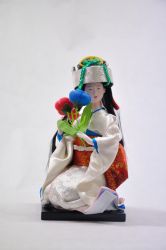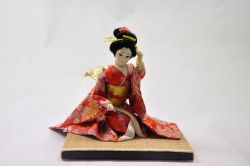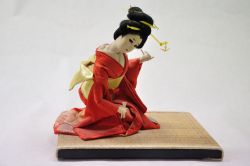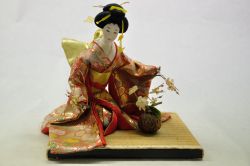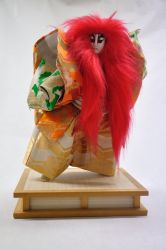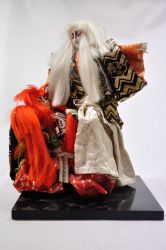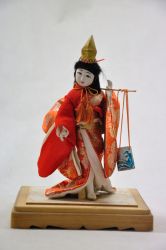Isho Ningyo
The name of these dolls, Isho Ningyo in Japanese, is made up of the word isho 衣装 (clothes, costume) and Ningyo 人形 (doll). Therefore, the name is often translated as "fashion doll". Although their tradition is not as long and rich as for other dolls in this catalogue, they do date back to the 18th century. These dolls are usually fixed on a platform or base. They assume poses of everyday life, also reflected by the choice of the costumes. Under the term “Isho Ningyo” not only dolls in anonymous poses and costumes are categozied, but in addition those who represent figures from a distinct class of society (such as nobles, courtesans, geisha / geiko etc.). Sometimes a specific role in a play is assigned to given dolls. The Isho Ningyo, as well as the Musha Ningyo dolls are either completely covered with colored silk or were built with the use of the hina ningyo porcelaine or plastic such as for limbs and heads. Qualitatively, there are major differences, since some of them were made using material from craft kits which most people can use by themselves, others are exhibited in high quality glass cases giving them a very noble touch. Some of these Isho Ningyo are mobile, so that they can be moved or made to sit down. Some, i.e. the onnagata 女 形 (also read Oyama), represent male actors playing a female role, exhibiting male genitals. The appearance and character of these dolls can be changed by using different wigs, in a way to modify the role of the dolls. For example, a female doll can be displayed as a single and/or married woman or an actor doll can be changed to emerge from another piece or interpreting a different character.
The dolls can also be placed in groups of two or three figures, in which case they usually represent roles of Kabuki or Noh plays. Depending on their preparation, they stand on a small stage with a background on which a tree or a landscape is painted. This collection of Isho Ningyo dolls displays a remarkable wealth of variation, i.e those whose iconography clearly is based on Kabuki plays as well as few that are based on Noh theater plays. These dolls are also often called Oyama Ningyo 女 形 人形 instead of Isho Ningyo. The following are some Isho Ningyo that also belong to this category.
